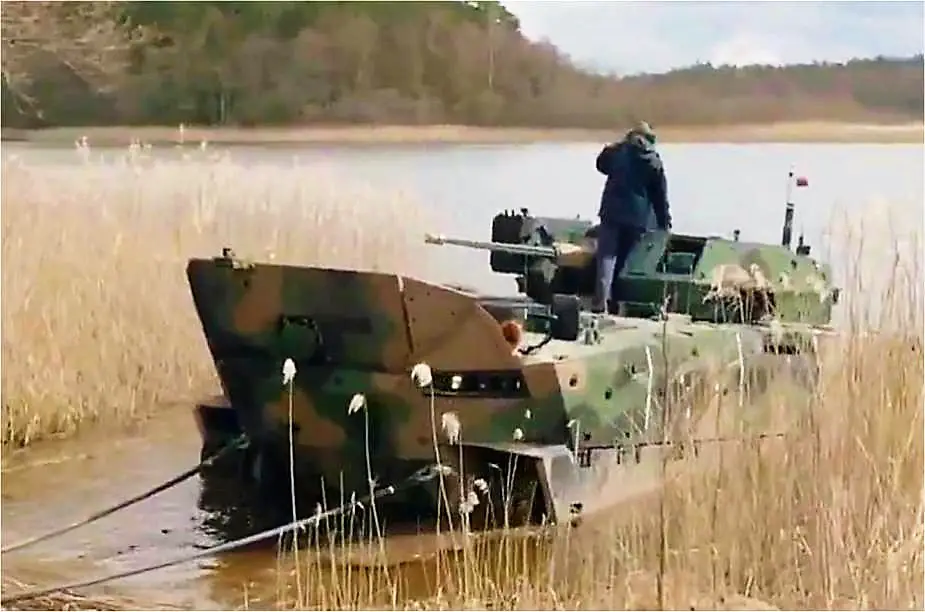Breaking news
PGZ from Poland conducts amphibious and firing tests with Borsuk IFV.
The new Polish amphibious infantry fighting vehicle Borsuk is undergoing its most important tests on land and water, as shown by PGZ on its Twitter account. An integral part of this test is firing the anti-tank guided missile.
Follow Army Recognition on Google News at this link

Borsuk IFV during amphibious tests (Picture source: Screenshot from video footage of Polsat TV Poland)
Borsuk (Badger) is an amphibious infantry fighting vehicle produced by Huta Stalowa Wola, a part of PGZ (Polish Armaments Group). It is designed to replace the obsolete BWP-1 (Polish designation for BMP-1) IFV currently in service with the Polish Armed Forces. Although often referred to as BWP Borsuk, BWP is not a part of the name but the Polish abbreviation for Bojowy Wóz Piechoty - Infantry Fighting Vehicle.
Borsuk is powered by a powerpack consisting of a 720 hp (530 kW) MTU 8V199 TE20 turbo diesel engine, which drives a 6-gear (4 forward and 2 reverse gears) Perkins X300 automatic transmission. The hydropneumatic suspension is designed specifically for the Borsuk and consists of six independent in-arm units on each side. Borsuk is able to use different types of tracks: it was presented on different occasions outfitted with steel tracks or composite rubber tracks (CRT).
The vehicle is fully amphibious without any special preparations - crossing a body of water only requires raising the trim vane (which can be done from the driver seat without the necessity of leaving the vehicle). In the water, Borsuk is propelled by two water jets with rotating nozzles and steering capability.
The Borsuk's maximum speed is 65 km/h on the road and 8 km/h in the water. Its operational range is 550 km.
Borsuk is fitted with a ZSSW-30 remotely controlled turret armed with a 30mm Mk.44S Bushmaster II chain gun and a coaxial 7.62 mm UKM-2000C machine gun. The turret also features two Spike-LR anti-tank guided missiles in a launch container mounted on its right side. The ZSSW-30 provides around 300 autocannon rounds, including over 200 ABM rounds, and 250 machine gun rounds in ready-to-use mode. This is one of the biggest first-stage ammunition racks when compared to other similar systems.
Using a separate ATGM launch container, as opposed to other systems where the launcher extends directly from an internal compartment of the turret, has some advantages. Among those are the separation of the missiles from the rest of the turret (and thus greater safety of the crew and the turret itself) and the ability to quickly replace damaged or destroyed containers while in the field. Both the autocannon and the machine gun can be reloaded and operated from the inside of the turret. The ATGMs can be reloaded from a hatch in the rear of the vehicle without the necessity for the crew to leave the vehicle (in the same manner as it is being done in the Bradley IFV.
The autocannon fires at a rate of 200 RPM for standard ammunition, and 120 RPM for ABM. It has elevation angles extending from -9° to +60°. The ATGMs can hit armor at ranges from 200 meters to 4 km when guided manually, and up to 4.5 km when in the fire and forget mode.
The ZSSW-30 fire control system made by WB Group provides full hunter-killer and killer-killer capabilities as well as superb accuracy when firing at moving targets from both moving and standing positions. The fire control system allows for shooting in every position of the turret relative to the hull in all three axes (which is not a common feature for other comparable systems). The entire firing process is highly automated as both the gunner and the commander have an auto-tracker integrated into the FCS. The ZSSW-30 FCS is net-centric as it can transfer and coordinate information between different turrets as well as communicate with various types of UAVs. Both of those features greatly increase the situational awareness and combat effectiveness of each and every vehicle.
Defense News April 2023




























